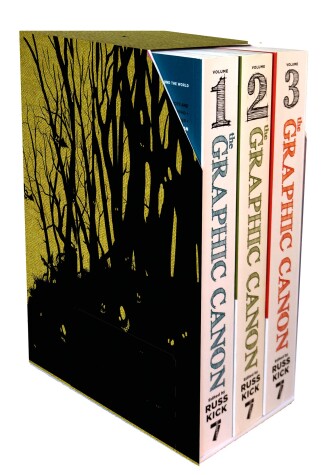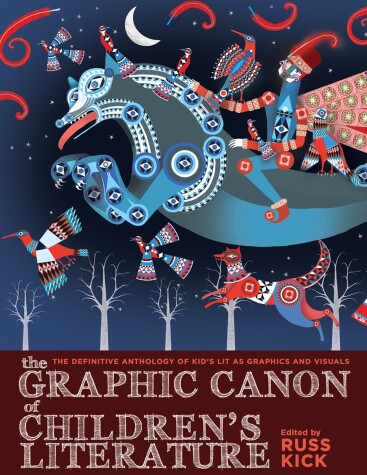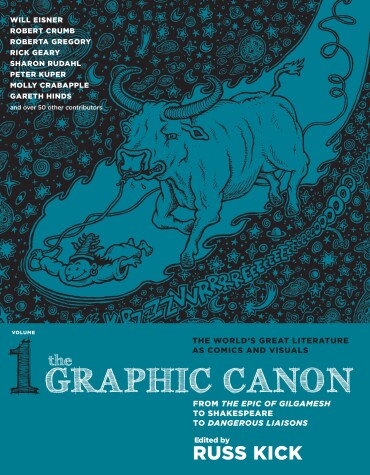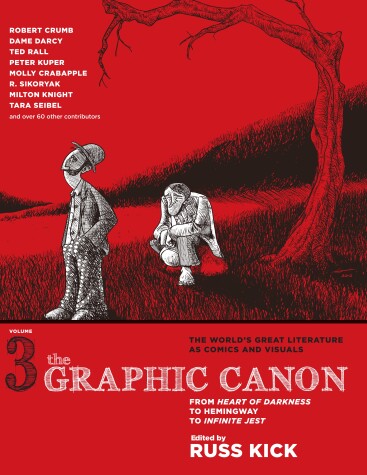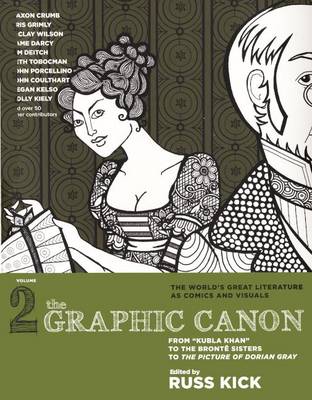Graphic Canon
6 total works
The Graphic Canon, Volume 2 gives us a visual cornucopia based on the wealth of literature from the 1800s. Several artists—including Maxon Crumb and Gris Grimly—present their versions of Edgar Allan Poe’s visions. The great American novel Huckleberry Finn is adapted uncensored for the first time, as Twain wrote it. The bad boys of Romanticism—Shelley, Keats, and Byron—are visualized here, and so are the Brontë sisters. We see both of Coleridge’s most famous poems: “Kubla Khan” and “The Rime of the Ancient Mariner” (the latter by British comics legend Hunt Emerson). Philosophy and science are ably represented by ink versions of Nietzsche’sThus Spake Zarathustra and Darwin’s On the Origin of Species.
Frankenstein, Moby-Dick, Les Misérables, Great Expectations, Middlemarch, Anna Karenina, Crime and Punishment (a hallucinatory take on the pivotal murder scene), Thoreau’s Walden (in spare line art by John Porcellino of King-Cat Comics fame), “The Drunken Boat” by Rimbaud, Leaves of Grass by Whitman, and two of Emily Dickinson’s greatest poems are all present and accounted for. John Coulthart has created ten magnificent full-page collages that tell the story of The Picture of Dorian Gray by Oscar Wilde. And Pride and Prejudice has never looked this splendiferous!
This volume is a special treat for Lewis Carroll fans. Dame Darcy puts her unmistakable stamp on—what else?—the Alice books in a new 16-page tour-de-force, while a dozen other artists present their versions of the most famous characters and moments from Wonderland. There’s also a gorgeous silhouetted telling of “Jabberwocky,” and Mahendra’s Singh’s surrealistic take on “The Hunting of the Snark.”
Curveballs in this volume include fairy tales illustrated by the untameable S. Clay Wilson, a fiery speech from freed slave Frederick Douglass (rendered in stark black and white by Seth Tobocman), a letter on reincarnation from Flaubert, the Victorian erotic classic Venus in Furs, the drug classic The Hasheesh Eater, and silk-screened illustrations for the ghastly children’s classic Der Struwwelpeter. Among many other canonical works.
Frankenstein, Moby-Dick, Les Misérables, Great Expectations, Middlemarch, Anna Karenina, Crime and Punishment (a hallucinatory take on the pivotal murder scene), Thoreau’s Walden (in spare line art by John Porcellino of King-Cat Comics fame), “The Drunken Boat” by Rimbaud, Leaves of Grass by Whitman, and two of Emily Dickinson’s greatest poems are all present and accounted for. John Coulthart has created ten magnificent full-page collages that tell the story of The Picture of Dorian Gray by Oscar Wilde. And Pride and Prejudice has never looked this splendiferous!
This volume is a special treat for Lewis Carroll fans. Dame Darcy puts her unmistakable stamp on—what else?—the Alice books in a new 16-page tour-de-force, while a dozen other artists present their versions of the most famous characters and moments from Wonderland. There’s also a gorgeous silhouetted telling of “Jabberwocky,” and Mahendra’s Singh’s surrealistic take on “The Hunting of the Snark.”
Curveballs in this volume include fairy tales illustrated by the untameable S. Clay Wilson, a fiery speech from freed slave Frederick Douglass (rendered in stark black and white by Seth Tobocman), a letter on reincarnation from Flaubert, the Victorian erotic classic Venus in Furs, the drug classic The Hasheesh Eater, and silk-screened illustrations for the ghastly children’s classic Der Struwwelpeter. Among many other canonical works.
THE GRAPHIC CANON (Seven Stories Press) is a gorgeous, one-of-a-kind trilogy that brings classic literatures of the world together with legendary graphic artists and illustrators. There are more than 130 illustrators represented and 190 literary works over three volumes—many newly commissioned, some hard to find—reinterpreted here for readers and collectors of all ages.
Volume 1 takes us on a visual tour from the earliest literature through the end of the 1700s. Along the way, we're treated to eye-popping renditions of the human race's greatest epics: Gilgamesh, The Iliad, The Odyssey (in watercolors by Gareth Hinds), The Aeneid, Beowulf, and The Arabian Nights, plus later epics The Divine Comedy and The Canterbury Tales (both by legendary illustrator and graphic designer Seymour Chwast), Paradise Lost, and Le Morte D'Arthur. Two of ancient Greece's greatest plays are adapted—the tragedy Medea by Euripides and Tania Schrag’s uninhibited rendering of the very bawdy comedy Lysistrata by Aristophanes (the text of which is still censored in many textbooks). Also included is Robert Crumb’s rarely-seen adaptation of James Boswell’s London Journal, filled with philosophical debate and lowbrow debauchery.
Religious literature is well-covered and well-illustrated, with the Books of Daniel and Esther from the Old Testament, Rick Geary’s awe-inspiring new rendition of the Book of Revelation from the New Testament, the Tao te Ching, Rumi’s Sufi poetry, Hinduism’s Mahabharata, and the Mayan holy book Popol Vuh, illustrated by Roberta Gregory. The Eastern canon gets its due, with The Tale of Genji (the world’s first novel, done in full-page illustrations reminiscent of Aubrey Beardsley), three poems from China’s golden age of literature lovingly drawn by pioneering underground comics artist Sharon Rudahl, the Tibetan Book of the Dead, a Japanese Noh play, and other works from Asia.
Two of Shakespeare’s greatest plays (King Lear and A Midsummer Night’s Dream) and two of his sonnets are here, as are Plato’s Symposium, Gulliver’s Travels, Candide, A Vindication of the Rights of Woman, Renaissance poetry of love and desire, and Don Quixote visualized by the legendary Will Eisner.
Some unexpected twists include a Native American folktale, an Incan play, Sappho’s poetic fragments, bawdy essays by Benjamin Franklin, the love letters of Abelard and Heloise, and the decadent French classic Dangerous Liaisons, as illustrated by Molly
Crabapple.
The Graphic Canon, Volume 2 gives us a visual cornucopia based on the wealth of literature from the 1800s. Several artists—including Maxon Crumb and Gris Grimly—present their versions of Edgar Allan Poe’s visions. The great American novel Huckleberry Finn is adapted uncensored for the first time, as Twain wrote it. The bad boys of Romanticism—Shelley, Keats, and Byron—are visualized here, and so are the Brontë sisters. We see both of Coleridge’s most famous poems: “Kubla Khan” and “The Rime of the Ancient Mariner” (the latter by British comics legend Hunt Emerson). Philosophy and science are ably represented by ink versions of Nietzsche’sThus Spake Zarathustra and Darwin’s On the Origin of Species.
Frankenstein, Moby-Dick, Les Misérables, Great Expectations, Middlemarch, Anna Karenina, Crime and Punishment (a hallucinatory take on the pivotal murder scene), Thoreau’s Walden (in spare line art by John Porcellino of King-Cat Comics fame), “The Drunken Boat” by Rimbaud, Leaves of Grass by Whitman, and two of Emily Dickinson’s greatest poems are all present and accounted for. John Coulthart has created ten magnificent full-page collages that tell the story of The Picture of Dorian Gray by Oscar Wilde. And Pride and Prejudice has never looked this splendiferous!
Dame Darcy puts her unmistakable stamp on—what else?—the Alice books in a new 16-page tour-de-force, while a dozen other artists present their versions of the most famous characters and moments from Wonderland. There’s also a gorgeous silhouetted telling of “Jabberwocky,” and Mahendra’s Singh’s surrealistic take on “The Hunting of the Snark.”
Curveballs include fairy tales illustrated by the untameable S. Clay Wilson, a fiery speech from freed slave Frederick Douglass (rendered in stark black and white by Seth Tobocman), a letter on reincarnation from Flaubert, the Victorian erotic classic Venus in Furs, the drug classic The Hasheesh Eater, and silk-screened illustrations for the ghastly children’s classic Der Struwwelpeter. Among many other canonical works.
Volume 3 brings to life the literature of the end of the 20th century and the start of the 21st, including a Sherlock Holmes mystery, an H.G. Wells story, an illustrated guide to the Beat writers, a one-act play from Zora Neale Hurston, a disturbing meditation on Naked Lunch, Rilke's soul-stirring Letters to a Young Poet, Anaïs Nin's diaries, the visions of Black Elk, the heroin classic The Man With the Golden Arm (published four years before William Burroughs' Junky), and the postmodernism of Thomas Pynchon, David Foster Wallace, Kathy Acker, Raymond Carver, and Donald Barthelme.
The towering works of modernism are here--T.S. Eliot's "The Love Song of J. Alfred Prufrock" and "The Waste Land," Yeats's "The Second Coming" done as a magazine spread, Heart of Darkness, stories from Kafka, The Voyage Out by Virginia Woolf, James Joyce's masterpiece, Ulysses, and his short story "Araby" from Dubliners, rare early work from Faulkner and Hemingway (by artists who have drawn for Marvel), and poems by Gertrude Stein and Edna St. Vincent Millay.
You'll also find original comic versions of short stories by W. Somerset Maugham, Flannery O'Connor, and Saki (manga style), plus adaptations of Lolita (and everyone said it couldn't be done!), The Age of Innocence, Siddhartha and Steppenwolf by Hermann Hesse, "The Negro Speaks of Rivers" by Langston Hughes, One Flew Over the Cuckoo's Nest, Last Exit to Brooklyn, J.G. Ballard's Crash, and photo-dioramas for Animal Farm and The Wonderful Wizard of Oz. Feast your eyes on new full-page illustrations for 1984, Brave New World, Waiting for Godot, One Hundred Years of Solitude,The Bell Jar, On the Road, Lord of the Flies, The Wind-Up Bird Chronicle, and three Borges stories.
Robert Crumb's rarely seen adaptation of Nausea captures Sartre's existential dread. Dame Darcy illustrates Cormac McCarthy's masterpiece, Blood Meridian, universally considered one of the most brutal novels ever written and long regarded as unfilmable by Hollywood. Tara Seibel, the only female artist involved with the Harvey Pekar Project, turns in an exquisite series of illustrations for The Great Gatsby. And then there's the moment we've been waiting for: the first graphic adaptation from Kurt Vonnegut's masterwork, Slaughterhouse-Five. Among many other gems.
The classic canon of Western civilization meets the artists and illustrators who have remade reading in the last years of the twentieth century and the first decade of the twenty-first century in Russ Kick's magisterial, three-volume, full-color The Graphic Canon, volumes 1, 2, and 3.
This special slipcase edition includes all three volumes of the series in an attractively designed slipcase, allowing graphic novel collectors and fans to quickly add this seminal work to their library.
Volume 1 takes us on a visual tour from the earliest literature through the end of the 1700s. Along the way, we're treated to eye-popping renditions of the human race's greatest epics: Gilgamesh, The Iliad, The Odyssey (in watercolors by Gareth Hinds), The Aeneid, Beowulf, and The Arabian Nights, plus later epics The Divine Comedy and The Canterbury Tales (both by legendary illustrator and graphic designer Seymour Chwast), Paradise Lost, and Le Morte D'Arthur. Two of ancient Greece's greatest plays are adapted—the tragedy Medea by Euripides and Tania Schrag’s uninhibited rendering of the very bawdy comedy Lysistrata by Aristophanes (the text of which is still censored in many textbooks). Also included is Robert Crumb’s rarely-seen adaptation of James Boswell’s London Journal, filled with philosophical debate and lowbrow debauchery.
Religious literature is well-covered and well-illustrated, with the Books of Daniel and Esther from the Old Testament, Rick Geary’s awe-inspiring new rendition of the Book of Revelation from the New Testament, the Tao te Ching, Rumi’s Sufi poetry, Hinduism’s Mahabharata, and the Mayan holy book Popol Vuh, illustrated by Roberta Gregory. The Eastern canon gets its due, with The Tale of Genji (the world’s first novel, done in full-page illustrations reminiscent of Aubrey Beardsley), three poems from China’s golden age of literature lovingly drawn by pioneering underground comics artist Sharon Rudahl, the Tibetan Book of the Dead, a Japanese Noh play, and other works from Asia.
Two of Shakespeare’s greatest plays (King Lear and A Midsummer Night’s Dream) and two of his sonnets are here, as are Plato’s Symposium, Gulliver’s Travels, Candide, A Vindication of the Rights of Woman, Renaissance poetry of love and desire, and Don Quixote visualized by the legendary Will Eisner.
Some unexpected twists include a Native American folktale, an Incan play, Sappho’s poetic fragments, bawdy essays by Benjamin Franklin, the love letters of Abelard and Heloise, and the decadent French classic Dangerous Liaisons, as illustrated by Molly
Crabapple.
The Graphic Canon, Volume 2 gives us a visual cornucopia based on the wealth of literature from the 1800s. Several artists—including Maxon Crumb and Gris Grimly—present their versions of Edgar Allan Poe’s visions. The great American novel Huckleberry Finn is adapted uncensored for the first time, as Twain wrote it. The bad boys of Romanticism—Shelley, Keats, and Byron—are visualized here, and so are the Brontë sisters. We see both of Coleridge’s most famous poems: “Kubla Khan” and “The Rime of the Ancient Mariner” (the latter by British comics legend Hunt Emerson). Philosophy and science are ably represented by ink versions of Nietzsche’sThus Spake Zarathustra and Darwin’s On the Origin of Species.
Frankenstein, Moby-Dick, Les Misérables, Great Expectations, Middlemarch, Anna Karenina, Crime and Punishment (a hallucinatory take on the pivotal murder scene), Thoreau’s Walden (in spare line art by John Porcellino of King-Cat Comics fame), “The Drunken Boat” by Rimbaud, Leaves of Grass by Whitman, and two of Emily Dickinson’s greatest poems are all present and accounted for. John Coulthart has created ten magnificent full-page collages that tell the story of The Picture of Dorian Gray by Oscar Wilde. And Pride and Prejudice has never looked this splendiferous!
Dame Darcy puts her unmistakable stamp on—what else?—the Alice books in a new 16-page tour-de-force, while a dozen other artists present their versions of the most famous characters and moments from Wonderland. There’s also a gorgeous silhouetted telling of “Jabberwocky,” and Mahendra’s Singh’s surrealistic take on “The Hunting of the Snark.”
Curveballs include fairy tales illustrated by the untameable S. Clay Wilson, a fiery speech from freed slave Frederick Douglass (rendered in stark black and white by Seth Tobocman), a letter on reincarnation from Flaubert, the Victorian erotic classic Venus in Furs, the drug classic The Hasheesh Eater, and silk-screened illustrations for the ghastly children’s classic Der Struwwelpeter. Among many other canonical works.
Volume 3 brings to life the literature of the end of the 20th century and the start of the 21st, including a Sherlock Holmes mystery, an H.G. Wells story, an illustrated guide to the Beat writers, a one-act play from Zora Neale Hurston, a disturbing meditation on Naked Lunch, Rilke's soul-stirring Letters to a Young Poet, Anaïs Nin's diaries, the visions of Black Elk, the heroin classic The Man With the Golden Arm (published four years before William Burroughs' Junky), and the postmodernism of Thomas Pynchon, David Foster Wallace, Kathy Acker, Raymond Carver, and Donald Barthelme.
The towering works of modernism are here--T.S. Eliot's "The Love Song of J. Alfred Prufrock" and "The Waste Land," Yeats's "The Second Coming" done as a magazine spread, Heart of Darkness, stories from Kafka, The Voyage Out by Virginia Woolf, James Joyce's masterpiece, Ulysses, and his short story "Araby" from Dubliners, rare early work from Faulkner and Hemingway (by artists who have drawn for Marvel), and poems by Gertrude Stein and Edna St. Vincent Millay.
You'll also find original comic versions of short stories by W. Somerset Maugham, Flannery O'Connor, and Saki (manga style), plus adaptations of Lolita (and everyone said it couldn't be done!), The Age of Innocence, Siddhartha and Steppenwolf by Hermann Hesse, "The Negro Speaks of Rivers" by Langston Hughes, One Flew Over the Cuckoo's Nest, Last Exit to Brooklyn, J.G. Ballard's Crash, and photo-dioramas for Animal Farm and The Wonderful Wizard of Oz. Feast your eyes on new full-page illustrations for 1984, Brave New World, Waiting for Godot, One Hundred Years of Solitude,The Bell Jar, On the Road, Lord of the Flies, The Wind-Up Bird Chronicle, and three Borges stories.
Robert Crumb's rarely seen adaptation of Nausea captures Sartre's existential dread. Dame Darcy illustrates Cormac McCarthy's masterpiece, Blood Meridian, universally considered one of the most brutal novels ever written and long regarded as unfilmable by Hollywood. Tara Seibel, the only female artist involved with the Harvey Pekar Project, turns in an exquisite series of illustrations for The Great Gatsby. And then there's the moment we've been waiting for: the first graphic adaptation from Kurt Vonnegut's masterwork, Slaughterhouse-Five. Among many other gems.
The classic canon of Western civilization meets the artists and illustrators who have remade reading in the last years of the twentieth century and the first decade of the twenty-first century in Russ Kick's magisterial, three-volume, full-color The Graphic Canon, volumes 1, 2, and 3.
This special slipcase edition includes all three volumes of the series in an attractively designed slipcase, allowing graphic novel collectors and fans to quickly add this seminal work to their library.
The original three-volume anthology The Graphic Canon presented the world's classic literature--from ancient times to the late twentieth century--as eye-popping comics, illustrations, and other visual forms. In this follow-up volume, young people's literature through the ages is given new life by the best comics artists and illustrators. Fairy tales, fables, fantastical adventures, young adult novels, swashbuckling yarns, your favorite stories from childhood and your teenage years . . . they're all here, in all their original complexity and strangeness, before they were censored or sanitized.
THE GRAPHIC CANON (Seven Stories Press) is a gorgeous, one-of-a-kind trilogy that brings classic literatures of the world together with legendary graphic artists and illustrators. There are more than 130 illustrators represented and 190 literary works over three volumes—many newly commissioned, some hard to find—reinterpreted here for readers and collectors of all ages.
Volume 1 takes us on a visual tour from the earliest literature through the end of the 1700s. Along the way, we're treated to eye-popping renditions of the human race's greatest epics: Gilgamesh, The Iliad, The Odyssey (in watercolors by Gareth Hinds), The Aeneid, Beowulf, and The Arabian Nights, plus later epics The Divine Comedy and The Canterbury Tales (both by legendary illustrator and graphic designer Seymour Chwast), Paradise Lost, and Le Morte D'Arthur. Two of ancient Greece's greatest plays are adapted—the tragedy Medea by Euripides and Tania Schrag’s uninhibited rendering of the very bawdy comedy Lysistrata by Aristophanes (the text of which is still censored in many textbooks). Also included is Robert Crumb’s rarely-seen adaptation of James Boswell’s London Journal, filled with philosophical debate and lowbrow debauchery.
Religious literature is well-covered and well-illustrated, with the Books of Daniel and Esther from the Old Testament, Rick Geary’s awe-inspiring new rendition of the Book of Revelation from the New Testament, the Tao te Ching, Rumi’s Sufi poetry, Hinduism’s Mahabharata, and the Mayan holy book Popol Vuh, illustrated by Roberta Gregory. The Eastern canon gets its due, with The Tale of Genji (the world’s first novel, done in full-page illustrations reminiscent of Aubrey Beardsley), three poems from China’s golden age of literature lovingly drawn by pioneering underground comics artist Sharon Rudahl, the Tibetan Book of the Dead, a Japanese Noh play, and other works from Asia.
Two of Shakespeare’s greatest plays (King Lear and A Midsummer Night’s Dream) and two of his sonnets are here, as are Plato’s Symposium, Gulliver’s Travels, Candide, A Vindication of the Rights of Woman, Renaissance poetry of love and desire, and Don Quixote visualized by the legendary Will Eisner.
Some unexpected twists in this volume include a Native American folktale, an Incan play, Sappho’s poetic fragments, bawdy essays by Benjamin Franklin, the love letters of Abelard and Heloise, and the decadent French classic Dangerous Liaisons, as illustrated by Molly
Crabapple.
Edited by Russ Kick, The Graphic Canon is an extraordinary collection that will continue with Volume 2: "Kubla Khan" to the Bronte Sisters to The Picture of Dorian Gray in Summer 2012, and Volume 3: From Heart of Darkness to Hemingway to Infinite Jest in Fall 2012. A boxed set of all three volumes will also be published in Fall 2012.
Volume 1 takes us on a visual tour from the earliest literature through the end of the 1700s. Along the way, we're treated to eye-popping renditions of the human race's greatest epics: Gilgamesh, The Iliad, The Odyssey (in watercolors by Gareth Hinds), The Aeneid, Beowulf, and The Arabian Nights, plus later epics The Divine Comedy and The Canterbury Tales (both by legendary illustrator and graphic designer Seymour Chwast), Paradise Lost, and Le Morte D'Arthur. Two of ancient Greece's greatest plays are adapted—the tragedy Medea by Euripides and Tania Schrag’s uninhibited rendering of the very bawdy comedy Lysistrata by Aristophanes (the text of which is still censored in many textbooks). Also included is Robert Crumb’s rarely-seen adaptation of James Boswell’s London Journal, filled with philosophical debate and lowbrow debauchery.
Religious literature is well-covered and well-illustrated, with the Books of Daniel and Esther from the Old Testament, Rick Geary’s awe-inspiring new rendition of the Book of Revelation from the New Testament, the Tao te Ching, Rumi’s Sufi poetry, Hinduism’s Mahabharata, and the Mayan holy book Popol Vuh, illustrated by Roberta Gregory. The Eastern canon gets its due, with The Tale of Genji (the world’s first novel, done in full-page illustrations reminiscent of Aubrey Beardsley), three poems from China’s golden age of literature lovingly drawn by pioneering underground comics artist Sharon Rudahl, the Tibetan Book of the Dead, a Japanese Noh play, and other works from Asia.
Two of Shakespeare’s greatest plays (King Lear and A Midsummer Night’s Dream) and two of his sonnets are here, as are Plato’s Symposium, Gulliver’s Travels, Candide, A Vindication of the Rights of Woman, Renaissance poetry of love and desire, and Don Quixote visualized by the legendary Will Eisner.
Some unexpected twists in this volume include a Native American folktale, an Incan play, Sappho’s poetic fragments, bawdy essays by Benjamin Franklin, the love letters of Abelard and Heloise, and the decadent French classic Dangerous Liaisons, as illustrated by Molly
Crabapple.
Edited by Russ Kick, The Graphic Canon is an extraordinary collection that will continue with Volume 2: "Kubla Khan" to the Bronte Sisters to The Picture of Dorian Gray in Summer 2012, and Volume 3: From Heart of Darkness to Hemingway to Infinite Jest in Fall 2012. A boxed set of all three volumes will also be published in Fall 2012.
NOW A NEW YORK TIMES BESTSELLER!
Publisher's Weekly "Best Summer Books of 2013"
The Daily Beast's "Brainy Summer Beach Reads"
The classic literary canon meets the comics artists, illustrators, and other artists who have remade reading in Russ Kick's magisterial, three-volume, full-color The Graphic Canon, volumes 1, 2, and 3.
Volume 3 brings to life the literature of the end of the 20th century and the start of the 21st, including a Sherlock Holmes mystery, an H.G. Wells story, an illustrated guide to the Beat writers, a one-act play from Zora Neale Hurston, a disturbing meditation on Naked Lunch, Rilke's soul-stirring Letters to a Young Poet, Anaïs Nin's diaries, the visions of Black Elk, the heroin classic The Man With the Golden Arm (published four years before William Burroughs' Junky), and the postmodernism of Thomas Pynchon, David Foster Wallace, Kathy Acker, Raymond Carver, and Donald Barthelme.
The towering works of modernism are here--T.S. Eliot's "The Love Song of J. Alfred Prufrock" and "The Waste Land," Yeats's "The Second Coming" done as a magazine spread, Heart of Darkness, stories from Kafka, The Voyage Out by Virginia Woolf, James Joyce's masterpiece, Ulysses, and his short story "Araby" from Dubliners, rare early work from Faulkner and Hemingway (by artists who have drawn for Marvel), and poems by Gertrude Stein and Edna St. Vincent Millay.
You'll also find original comic versions of short stories by W. Somerset Maugham, Flannery O'Connor, and Saki (manga style), plus adaptations of Lolita (and everyone said it couldn't be done!), The Age of Innocence, Siddhartha and Steppenwolf by Hermann Hesse, "The Negro Speaks of Rivers" by Langston Hughes, One Flew Over the Cuckoo's Nest, Last Exit to Brooklyn, J.G. Ballard's Crash, and photo-dioramas for Animal Farm and The Wonderful Wizard of Oz. Feast your eyes on new full-page illustrations for 1984, Brave New World, Waiting for Godot, One Hundred Years of Solitude,The Bell Jar, On the Road, Lord of the Flies, The Wind-Up Bird Chronicle, and three Borges stories.
Robert Crumb's rarely seen adaptation of Nausea captures Sartre's existential dread. Dame Darcy illustrates Cormac McCarthy's masterpiece, Blood Meridian, universally considered one of the most brutal novels ever written and long regarded as unfilmable by Hollywood. Tara Seibel, the only female artist involved with the Harvey Pekar Project, turns in an exquisite series of illustrations for The Great Gatsby. And then there's the moment we've been waiting for: the first graphic adaptation from Kurt Vonnegut's masterwork, Slaughterhouse-Five. Among many other gems.
Publisher's Weekly "Best Summer Books of 2013"
The Daily Beast's "Brainy Summer Beach Reads"
The classic literary canon meets the comics artists, illustrators, and other artists who have remade reading in Russ Kick's magisterial, three-volume, full-color The Graphic Canon, volumes 1, 2, and 3.
Volume 3 brings to life the literature of the end of the 20th century and the start of the 21st, including a Sherlock Holmes mystery, an H.G. Wells story, an illustrated guide to the Beat writers, a one-act play from Zora Neale Hurston, a disturbing meditation on Naked Lunch, Rilke's soul-stirring Letters to a Young Poet, Anaïs Nin's diaries, the visions of Black Elk, the heroin classic The Man With the Golden Arm (published four years before William Burroughs' Junky), and the postmodernism of Thomas Pynchon, David Foster Wallace, Kathy Acker, Raymond Carver, and Donald Barthelme.
The towering works of modernism are here--T.S. Eliot's "The Love Song of J. Alfred Prufrock" and "The Waste Land," Yeats's "The Second Coming" done as a magazine spread, Heart of Darkness, stories from Kafka, The Voyage Out by Virginia Woolf, James Joyce's masterpiece, Ulysses, and his short story "Araby" from Dubliners, rare early work from Faulkner and Hemingway (by artists who have drawn for Marvel), and poems by Gertrude Stein and Edna St. Vincent Millay.
You'll also find original comic versions of short stories by W. Somerset Maugham, Flannery O'Connor, and Saki (manga style), plus adaptations of Lolita (and everyone said it couldn't be done!), The Age of Innocence, Siddhartha and Steppenwolf by Hermann Hesse, "The Negro Speaks of Rivers" by Langston Hughes, One Flew Over the Cuckoo's Nest, Last Exit to Brooklyn, J.G. Ballard's Crash, and photo-dioramas for Animal Farm and The Wonderful Wizard of Oz. Feast your eyes on new full-page illustrations for 1984, Brave New World, Waiting for Godot, One Hundred Years of Solitude,The Bell Jar, On the Road, Lord of the Flies, The Wind-Up Bird Chronicle, and three Borges stories.
Robert Crumb's rarely seen adaptation of Nausea captures Sartre's existential dread. Dame Darcy illustrates Cormac McCarthy's masterpiece, Blood Meridian, universally considered one of the most brutal novels ever written and long regarded as unfilmable by Hollywood. Tara Seibel, the only female artist involved with the Harvey Pekar Project, turns in an exquisite series of illustrations for The Great Gatsby. And then there's the moment we've been waiting for: the first graphic adaptation from Kurt Vonnegut's masterwork, Slaughterhouse-Five. Among many other gems.

